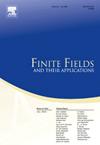NMDS码的表征及庚杨章周猜想的证明
IF 1.2
3区 数学
Q1 MATHEMATICS
引用次数: 0
摘要
设Fq是由q个元素组成的有限域,其中q=pm, p为素数,m为正整数。设C(q,n,δ,h)为一类长度为n,设计距离为δ的BCH码。如果最小距离d=n−k+1,则称线性码C为最大可分离距离(MDS)。如果d=n−k,则C称为几乎MDS (AMDS)代码。此外,如果C和它的对偶码C⊥都是AMDS,那么C被称为近MDS (NMDS)码。在[9]中,Geng, Yang, Zhang和Zhou证明了BCH码C(q,q+1,3,4)是一个几乎MDS码,其中q=3m, m为奇数,并证明了其参数为[q+1,q−3,4]。此外,他们提出了一个猜想,说明对偶码C(q,q+1,3,4)⊥也是一个参数为[q+1,4,q−3]的AMDS码。本文引入了子集码的概念,并结合MacWilliams恒等式建立了AMDS码的对偶码是AMDS码的表征。然后,根据这个标准,我们证明了庚杨章周猜想是正确的。我们的结果结合庚阳-张-周定理,证明了BCH码C(q,q+1,3,4)是一个NMDS码。本文章由计算机程序翻译,如有差异,请以英文原文为准。
Characterizations of NMDS codes and a proof of the Geng-Yang-Zhang-Zhou conjecture
Let be the finite field of q elements, where with p being a prime number and m being a positive integer. Let be a class of BCH codes of length n and designed distance δ. A linear code is said to be maximum distance separable (MDS) if the minimum distance . If , then is called an almost MDS (AMDS) code. Moreover, if both of and its dual code are AMDS, then is called a near MDS (NMDS) code. In [9], Geng, Yang, Zhang and Zhou proved that the BCH code is an almost MDS code, where and m is an odd integer, and they also showed that its parameters is . Furthermore, they proposed a conjecture stating that the dual code is also an AMDS code with parameters . In this paper, we introduce the concept of subset code and use it together with the MacWilliams identity to establish characterizations for the dual code of an AMDS code to be an AMDS code. Then by this criteria, we show that the Geng-Yang-Zhang-Zhou conjecture is true. Our result together with the Geng-Yang-Zhang-Zhou theorem implies that the BCH code is an NMDS code.
求助全文
通过发布文献求助,成功后即可免费获取论文全文。
去求助
来源期刊
CiteScore
2.00
自引率
20.00%
发文量
133
审稿时长
6-12 weeks
期刊介绍:
Finite Fields and Their Applications is a peer-reviewed technical journal publishing papers in finite field theory as well as in applications of finite fields. As a result of applications in a wide variety of areas, finite fields are increasingly important in several areas of mathematics, including linear and abstract algebra, number theory and algebraic geometry, as well as in computer science, statistics, information theory, and engineering.
For cohesion, and because so many applications rely on various theoretical properties of finite fields, it is essential that there be a core of high-quality papers on theoretical aspects. In addition, since much of the vitality of the area comes from computational problems, the journal publishes papers on computational aspects of finite fields as well as on algorithms and complexity of finite field-related methods.
The journal also publishes papers in various applications including, but not limited to, algebraic coding theory, cryptology, combinatorial design theory, pseudorandom number generation, and linear recurring sequences. There are other areas of application to be included, but the important point is that finite fields play a nontrivial role in the theory, application, or algorithm.

 求助内容:
求助内容: 应助结果提醒方式:
应助结果提醒方式:


